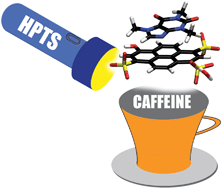 A team of researchers from Switzerland have used a commercially available fluorophore for detecting caffeine in water.
A team of researchers from Switzerland have used a commercially available fluorophore for detecting caffeine in water.
Previous methods for caffeine detection have been based on hydrogen-bonding receptors but these suffer from the need to use organic solvents. Whilst water-based detection has been achieved, the sensitivity and selectivity for caffeine was low.
Inspired by the known affinity of caffeine for polyaromatic compounds, Kay Severin and colleagues discovered that HPTS, a polysulfonated pyrene dye, can be used to selectively probe caffeine in liquid and solid samples. The team used the probe to quantify caffeine levels in soft drinks, coffee and painkillers, proving it can be used as a simpler alternative to HPLC.
Download the ChemComm article to find out more.










